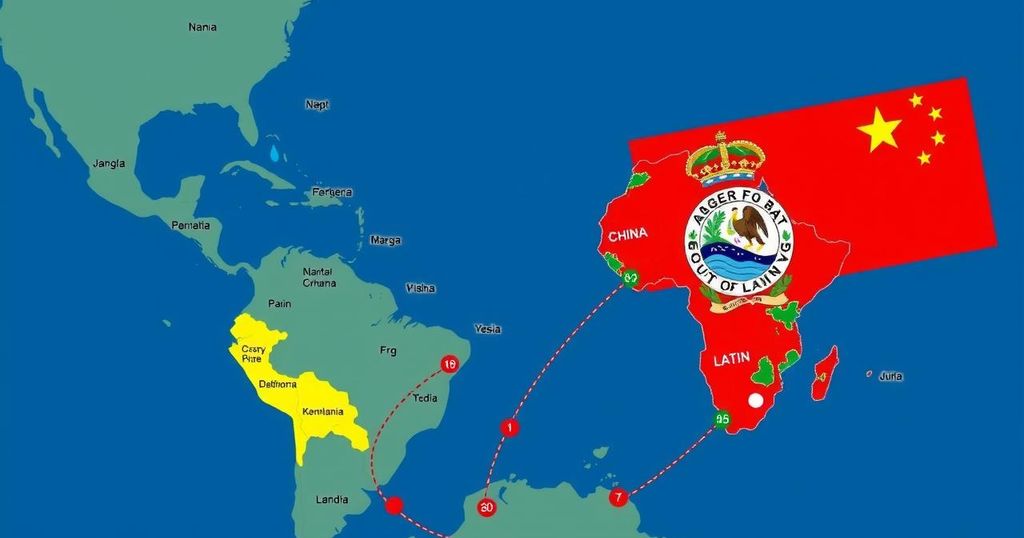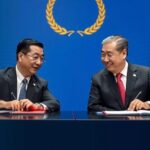Politics
ASIA, BILATERAL TRADE, BRAZIL, CHANCAY, CHILE, CHINA, COLOMBIA, COSCO SHIPPING CORPORATION, COUNCIL ON FOREIGN RELATIONS, CUBA, DINA BOLUARTE, DONALD TRUMP, ECONOMIC COOPERATION, ECUADOR, FLORIDA INTERNATIONAL UNIVERSITY, FOREIGN INVESTMENT, GEOPOLITICS, INTERNATIONAL TRADE, LATIN AMERICA, LELAND LAZARUS, LIMA, MEXICO, NORTH AMERICA, PERU, SOUTH AMERICA, TRADE, U. S, UNITED STATES, VOA, XI, XI JINPING, ZHIQUN ZHU
Nia Simpson
Xi Jinping’s Latin America Tour: Expanding China’s Global Influence
President Xi Jinping’s nine-day tour of Latin America aims to bolster China’s global influence, with a significant focus on inaugurating the Chancay mega-port in Peru. The port is set to enhance trade efficiency, providing economic benefits for several Latin American countries. However, the U.S. has expressed concerns about the port’s potential military use. Xi’s visit coincides with pivotal APEC and G20 summits, emphasizing China’s positioning as a responsible global power amidst U.S. policy uncertainties.
Chinese President Xi Jinping commenced a nine-day diplomatic tour of Latin America on Wednesday, focusing on expanding China’s global influence. His itinerary includes inaugurating the $3.5 billion Chancay mega-port in Peru and attending the Asia-Pacific Economic Cooperation Summit in Lima, as well as the G20 Summit in Brazil. Analysts observe that Xi’s tour emerges as a strategic response amidst growing uncertainties following the election of U.S. President-elect Donald Trump, positioning China as a proactive global player committed to multilateral cooperation. During his official visit to Peru, President Xi will formally open the Chancay port, located 80 kilometers from Lima. The port, equipped with a depth of 17.8 meters, is anticipated to function as a vital trade connection between Latin America and China. Lesser container shipment times promise significant economic benefits, as stated by Leland Lazarus of Florida International University, who noted, “The port will become the largest deep-water port in South America and it will drastically reduce the time needed to ship products from Peru to China.” China’s state-run enterprise, Cosco Shipping Corporation, holds a 60% stake and has secured a 30-year lease for port operations. Upon opening, the Chancay port can manage one million containers and 160,000 vehicles annually, facilitating efficient exports of essential commodities like lithium, copper, and soybeans. The port forms part of China’s broader Belt and Road Initiative, which currently encompasses over 100 global port projects. The anticipated benefits of the Chancay port extend to several Latin American nations, including Peru, Chile, and Brazil, which collectively exported $135 billion to China in 2023. According to Zhiqun Zhu from Bucknell University, The growing gap in infrastructure development within Global South nations has created a demand for Chinese investments in substantial projects, making initiatives like Chancay port warmly welcomed. The United States, however, has expressed concerns regarding the potential militarization of the port, fearing its dual-use capability could threaten U.S. interests in the region. General Laura Richardson has indicated that the port’s deep-water capacity makes it plausible for military applications. Yet, some experts maintain that Chinese naval power projection in Latin America is limited, with Peru unlikely to permit militarization of the facility. In conjunction with the Chancay port opening, Peruvian Foreign Minister Elmer Schialer revealed that approximately 30 agreements, including a revised free trade agreement, are to be established during Xi’s visit. This marks a shift in China’s Latin American investments towards enhancing logistical infrastructure and mineral access. Experts predict that as China increasingly looks to secure resources, its appetite for commodities from Latin America will expand correspondingly. As President Xi engages in the APEC and G20 summits, he is poised to underscore China’s role as a stable global power during a time when the U.S. could become more isolationist under the Trump administration. Lazarus notes that these summits provide a significant platform for Xi to showcase China’s commitment to global governance. Nonetheless, experts are skeptical about the overall effectiveness of these initiatives in achieving China’s strategic objectives, suggesting that while some nations may gravitate towards China’s image as a leader of the Global South, others may remain wary, recognizing the competitive nature of international relations.
Chinese President Xi Jinping’s diplomatic visit to Latin America is a calculated move aimed at solidifying China’s global stature, especially amidst uncertainty regarding U.S. foreign policy under the incoming Trump administration. Latin America, traditionally viewed as the United States’ sphere of influence, presents an opportunity for China to position itself as a champion of global development. This initiative aligns with China’s overarching Belt and Road Initiative, which seeks to bolster infrastructure connectivity and facilitate trade across various regions. The Chancay port project, pivotal in this endeavor, signifies China’s increased investment in Latin America, particularly in sectors that aid trade efficiency and resource extraction. The geopolitical implications are notable, given the apprehensions from the U.S. regarding possible military capabilities associated with such infrastructures. Observers are keen on how these developments will affect U.S.-Latin America relations and China’s continued push for influence.
In summary, President Xi Jinping’s tour of Latin America, including the inauguration of the Chancay port in Peru, underscores China’s strategic efforts to enhance its global influence and facilitate trade. The port’s significant capabilities promise economic benefits for Latin American countries, aligning with broader goals of the Belt and Road Initiative. While the visit highlights China’s commitment to multilateralism, it simultaneously raises concerns regarding potential military applications. The evolving dynamics of U.S.-China relations will likely influence future interactions in the region.
Original Source: www.voanews.com








Post Comment